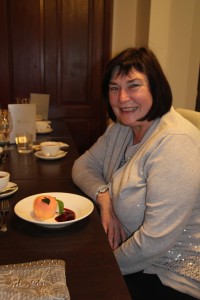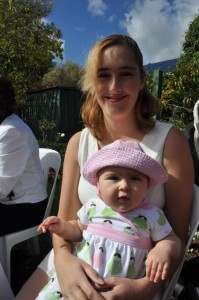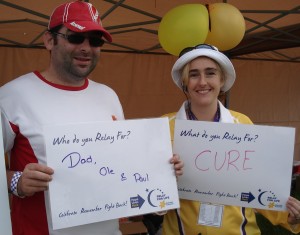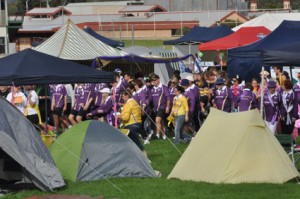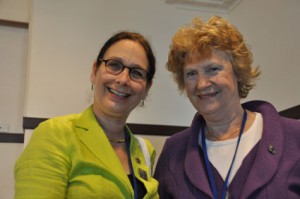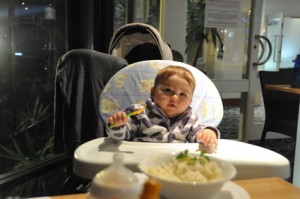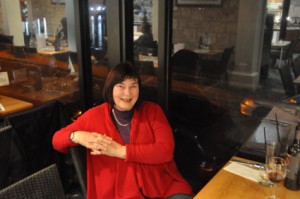May maketh days of diamonds – and some of stone
May has brought a bagful of new experiences, including reaching the first anniversary of the death of husband, Olivier on May 11. It was a date that I was dreading, yet it would draw to a close the worst year of my life where sorrow had soaked my being. I wanted desperately to avoid any more sadness and that would require beginning a new phase of life alone. Contentment would replace sadness and that horrid sense of loss.
I made a lightening decision to go to Perth for the Triennial International Congress of Lyceum Clubs and booked myself on the post-congress tour to Margaret River and Albany. I have only been a Lyceum member for three months and few women from Adelaide attended, so it was a leap of faith to decide to go. This would be stepping right out of my comfort zone and leaving my security nest, our beautiful home. No-one could say I have wallowed in a sense of despair beyond the first few months, but I have not been able to throw off that daily feeling of emptiness and, yes, lingering sadness behind the happy events I managed to snatch this past six months of 2013.
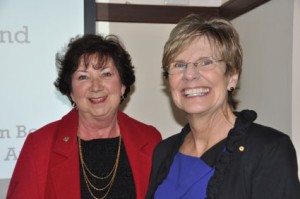
Lyceum Congress attendee Di Collins with keynote speaker WA’s chief scientist, Professor Lyn Beazley.
The women’s congress would be a first for me and as it unfolded in the luxurious Duxton Hotel in the company of dynamic women from around the globe, it was absolutely the right move to refocus on a new independent life as a widow. When Olivier was in his dying days, I told him that “In future I will return to my girlfriend life and my writing’’. Being in the company of women of an amazing level of intellectual grasp, of all ages, from many countries was a life-changing experience. It catapaulted me out of my introverted sense of loss into an enlightening view of a big wide world of new experiences.
After three days of exhilarating keynote speakers, superb food, social programs and meeting a host of new people, I took a four-day post-congress bus tour to the South-West of Australia to Margaret River and Albany. There were 29 of us and some were married couples, others had been career women who never married, and still others, like me, were widows. We were an eclectic bunch who blended beautifully. About half our number came from overseas – from Finland, Germany, Switzerland, the Netherlands and the United States bringing a wonderful richness of exchange as fellow tourists.
May 11 – a Saturday – was spent in quiet reflection at Margaret River lunching at Thompson Estates’ winery and touring the rugged coast. It summoned in me a past kind of happiness when Olivier and I stayed wiht his French friend Guy, the winemaker of Eagle Vale winery. It was very close and I telephoned him to find he did not know of Olivier’s death. Strangely, it was therapeutic to tell him of my journey with Olivier and his peaceful death and the struggles of the past 12 months. We promised to catch up when he and his wife Chantal visit Adelaide in July. It all triggered fond memories of that glorious estate with its sweeping vineyards, dams and bushland, which Guy had developed over 25 years. I had experienced it all with Olivier.
Back on the bus, half a dozen friends and my sister sent SMS messages in memory and it touched me deeply. Over these days I discovered two important aspects of recovery. The journey built on an emerging awareness of freedom and that my future will be created by my own decision-making; that it can be filled with chances which I could “catch on the wind’’. Life could still be an exciting adventure, even though it would be absolutely different from my fulfilling marriage to Olivier.
I returned home after 10 days with a notebook filled with new friends and overseas contacts.
However, the greatest joy in May has been my grand-daughter Scarlett, and the rich family life I enjoy with son Tyson and daughter-in-law Vanessa. As an example, Vanessa brought Scarlett to a fund-raising morning tea for the State Library Foundation in the gardens of historic Buxton Manor in North Adelaide. In my eyes, she stole the show, even though she wasn’t the youngest baby there. Vnessa ensured she wore a pretty bonnet to the hatty event. Olivier would have loved to have met her, if only for a few months. C’est la vie, it wasn’t to be.
888
